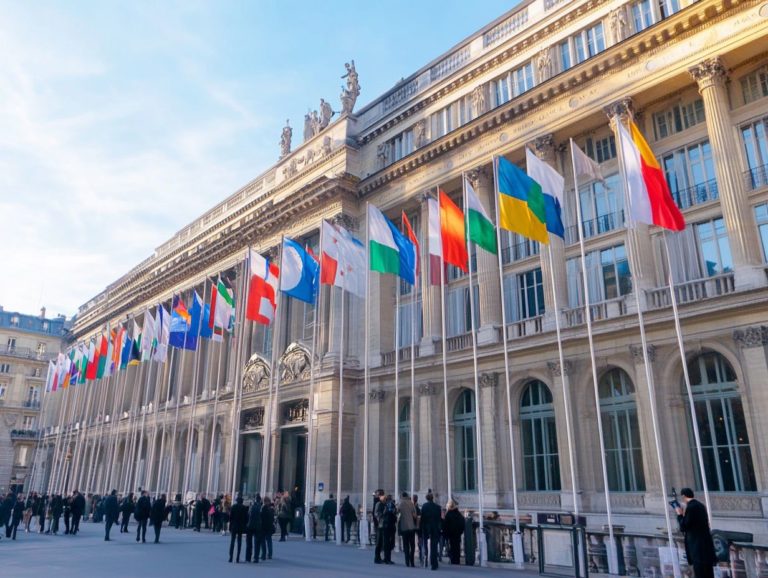Understanding the Berne Convention for Copyright
The Berne Convention for the Protection of Literary and Artistic Works has long served as a foundational pillar of international copyright law.
Created to safeguard creators’ rights across borders, this treaty articulates essential principles for protecting a diverse range of creative works, from literature to visual art.
In this exploration, you ll delve into the Convention s history and purpose, examining key principles such as automatic protection and minimum standards, alongside the obligations that member countries must uphold.
You ll also uncover the types of works that fall under its protection, the duration of that protection, and the significant exceptions that influence copyright law today.
Join us as we unravel the complexities of the Berne Convention and discover its profound impact on global creativity.
Contents
- Key Takeaways:
- Overview of the Berne Convention
- Key Principles of the Berne Convention
- Member Countries and Signatories
- Copyright Protection under the Berne Convention
- Exceptions and Limitations to Copyright Protection
- Frequently Asked Questions
- What is the Berne Convention for Copyright?
- When was the Berne Convention first established?
- Which countries are members of the Berne Convention?
- What are the key principles of the Berne Convention for Copyright?
- How does the Berne Convention affect copyright in my country?
- What Types of Works Are Covered by the Berne Convention?
Key Takeaways:

The Berne Convention automatically protects creative works without the need for registration or formalities.
The minimum standards of protection set by the Berne Convention ensure that creative works are safeguarded in all member countries.
Exceptions and limitations to copyright protection, such as fair use, are recognized and implemented under the Berne Convention.
Overview of the Berne Convention
The Berne Convention, officially established in 1886, stands as a cornerstone of international law, crafted to safeguard the rights of authors and creators worldwide.
By ensuring copyright protection for their literary and artistic works, this treaty lays the groundwork for a fair and equitable system. It promotes the independence of protection and fosters a supportive environment for creative individuals across member countries.
It also establishes minimum standards of protection, which are particularly vital for developing nations, enabling them to thrive in the artistic domain.
History and Purpose
The history of the Berne Convention takes you back to the late 19th century, a time when the need for a unified approach to copyright was becoming increasingly evident. This was essential for protecting artistic and literary works across national borders, allowing creators to safeguard their rights on an international scale.
The urgency for such an initiative emerged as print technology and global commerce flourished, exposing creators to an alarming risk of unauthorized reproduction and distribution of their works.
In 1886, a pivotal moment occurred when several nations gathered in Berne, Switzerland, to tackle these challenges together. The resulting treaty aimed to protect creators’ rights by ensuring their works received automatic protection in all member countries, setting the stage for international cooperation in copyright law.
This collaboration not only enhanced the rights of authors but also fostered a cultural exchange that enriched societies worldwide. It underscored the vital importance of protecting intellectual property as a shared global responsibility, emphasizing that the creative contributions of individuals are essential to the fabric of society.
Key Principles of the Berne Convention
The Berne Convention rests on three fundamental principles that form the bedrock of international copyright law: automatic protection of works, national treatment, and minimum protection standards.
These principles work in harmony to ensure that authors’ rights are respected and upheld, regardless of borders.
Automatic Protection of Works
Automatic protection stands as a cornerstone of the Berne Convention, guaranteeing that your works are safeguarded by copyright the moment they come into existence no registration or formalities required.
This principle ensures your rights are instantly protected, allowing you to focus on what you love creating!
Such immediate protection not only safeguards your intellectual property but also cultivates a lively atmosphere where creativity can thrive without the burden of bureaucratic red tape.
In contrast, many countries operate under a system that necessitates formal registration or other prerequisites, which can impede your ability to fully leverage your rights.
This difference highlights ongoing challenges in international copyright, as varying jurisdictions may impose different levels of protection, ultimately affecting how you navigate and benefit from your creations on a global scale.
Minimum Standards of Protection

The Berne Convention establishes minimum protection standards that member countries must follow. This ensures that authors enjoy vital rights, including the duration of protection for their works.
The baseline duration of copyright protection is the life of the author plus 50 years. However, many countries, such as those in the European Union, have opted to extend this period to 70 years after the author s passing. This framework gives creators various rights. These include the ability to reproduce, distribute, and publicly perform their works.
You can see the implications of these standards in the varying approaches across jurisdictions. For example, while the United States boasts a robust copyright framework through the Copyright Act, countries like India weave traditional practices into their interpretation of copyright law. This ensures protection not only for contemporary authors but also for folklore and cultural materials.
This diversity is exciting! It presents both challenges and amazing advantages of a global copyright approach. It promotes respect for artistic creation while navigating the complexities of different legal landscapes.
Member Countries and Signatories
The Berne Convention has a diverse membership of countries and signatories dedicated to upholding its principles. This collective commitment guarantees fair treatment for creators and protects copyright across numerous jurisdictions.
List of Countries and their Obligations
Member countries of the Berne Convention carry specific responsibilities to ensure that authors and their works receive robust copyright protection. These responsibilities include recognizing creators rights to control the distribution and reproduction of their work. They also establish a minimum duration of copyright protection typically lasting for the life of the author plus 50 years.
For example, the United States aligns with these standards, granting protection to works from the moment they are created. Germany, renowned for its rigorous copyright laws, similarly complies, ensuring that authors are afforded both moral and economic rights. The United Kingdom also upholds these copyright regulations, fostering trust and collaboration among nations.
Such commitments not only enable creators to monetize their works across borders but also promote vibrant cultural exchanges. Ultimately, this enriches society as a whole.
Copyright Protection under the Berne Convention
The Berne Convention stands as a cornerstone of copyright protection. It provides a robust framework that encompasses a wide array of creative works.
It carefully protects both the economic and moral rights of authors. This ensures that their contributions are respected and valued in the literary and artistic landscape.
Types of Works Covered
The Berne Convention encompasses a vast array of works. This includes literary creations, artistic masterpieces, and audiovisual productions, thus providing comprehensive copyright protection for diverse forms of expression.
- Novels
- Poems
- Plays
- Paintings
- Sculptures
- Music
- Films
- Architectural designs
This extensive range showcases the myriad ways you can convey your ideas and emotions. By safeguarding these works, the convention not only protects your rights as an author but also fosters cultural enrichment and innovation across nations.
For example, your original screenplay as a filmmaker, along with the resulting film, is entitled to protection under this agreement. This effectively prevents unauthorized reproduction and distribution.
The implications for copyright law are profound, enabling creators like you around the globe. It ensures that your intellectual contributions are acknowledged and compensated appropriately. This allows you to continue expressing your creativity without fear of infringement.
Duration of Protection

The duration of protection for works under the Berne Convention is an important part of copyright law. Member countries must follow these minimum standards.
This duration varies widely based on the type of work. For example, literary works are usually protected for the life of the author plus 50 years, while visual arts have different terms.
As an author or creator, this determines how long you control the reproduction and distribution of your work. This control can significantly impact your income and creative freedom.
However, individual countries interpret these guidelines differently. This creates a mix of protections, making it challenging for creators like you to navigate international markets.
Understanding local copyright laws is essential for compliance and to maximize your rights effectively.
Exceptions and Limitations to Copyright Protection
The Berne Convention acknowledges the importance of exceptions and limitations in copyright law. It creates a balance between protecting authors’ rights and serving public interests.
This allows creative works to be used in ways that benefit society while still respecting creators’ rights.
Fair Use and Other Exceptions
Fair use is a vital exception in copyright law. It allows you to use limited portions of copyrighted material without needing permission.
This promotes creativity and supports educational efforts while respecting authors’ rights. This framework is crucial for educators and creators who want to build on existing works.
Fair use permits the use of snippets for criticism or teaching, fostering a lively exchange of ideas. This exception is even more important alongside other provisions in the Berne Convention.
Such collaborative efforts help you thrive as a creative individual, allowing the artistic field to evolve with diverse interpretations.
Frequently Asked Questions
What is the Berne Convention for Copyright?
The Berne Convention for Copyright is an international agreement that outlines basic copyright principles. It establishes minimum standards for copyright protection and rights recognition for authors in member countries.
When was the Berne Convention first established?

The Berne Convention was first established in 1886 and has been revised several times, with the latest version adopted in 1979.
Which countries are members of the Berne Convention?
As of 2021, there are 178 member countries of the Berne Convention, including the United States, United Kingdom, France, Germany, Japan, and many more. You can find a full list on the World Intellectual Property Organization’s website.
What are the key principles of the Berne Convention for Copyright?
The key principles include automatic copyright protection, equal treatment of foreign and domestic works, and a minimum duration of copyright protection, which is the author’s life plus 50 years.
How does the Berne Convention affect copyright in my country?
If your country is a member of the Berne Convention, it agrees to uphold the minimum copyright standards. This includes recognizing the rights of foreign authors and protecting their works.
What Types of Works Are Covered by the Berne Convention?
The Berne Convention protects a variety of works. This includes literary, artistic, and scientific pieces, along with computer programs, databases, and architectural designs.
It also safeguards the rights of performers, producers of sound recordings, and broadcasting organizations.






